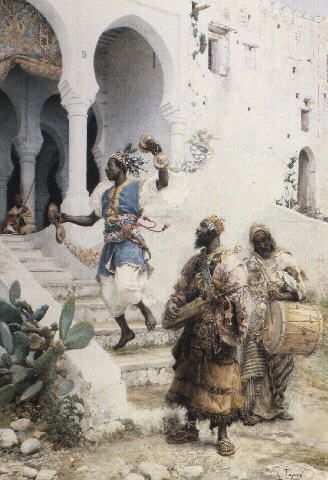GNAWA LIVE STREAM II
(![]() )
GNAWA LIVE STREAM III (
)
GNAWA LIVE STREAM III (![]() )
GNAWA LIVE STREAM IV
(
)
GNAWA LIVE STREAM IV
(![]() )
GNAWA LIVE STREAM V (
)
GNAWA LIVE STREAM V (![]() )
GNAWA LIVE STREAM VI (
)
GNAWA LIVE STREAM VI (![]() )
GNAWA LIVE STREAM VII (
)
GNAWA LIVE STREAM VII (![]() )
GNAWA LIVE STREAM VIII
(
)
GNAWA LIVE STREAM VIII
(![]() )
)

Gnawa's Historical Background
Gnawa and Diasporic African Power cited
from Egypt that Bab el-Kuhel
or Qasr were other references to
Bab Agnaou: the Black Gate.
Gnawa people built and walked beneath its ancient arch.
Slavery depopulated regions from
Chad to Kongo and Niger,
while bringing thousands to
modern-day Morocco...
Gnw- or -gnaw is generally used in the Amazigh language,
it refers to a thundering cloud.
Perhaps allusions also include
thousands of Black Africans' feet,
which marched via caravan from Timbuktu and further east.
"Gnawa are the black Moroccans.
They were taken in slavery as soldiers
from the ancient Mali Empire.
A lot of their songs, they sing about villages
like they talk about the cities of Bambara;
they sing about Segu,
which is [comprised of] ancient African
cities and empires, you know?"
Randy Weston said in 2009.
Foulani communities are found from Cameroon to Sudan,
and many Gnawa songs
reference them
"They migrated; they were taken up to North Africa,
and as most African people
do wherever they do,
whatever they come into contact with,
they create a spiritual music.
No matter what their religion is;
it makes no difference.
You find this is true in Brazil, in Cuba,
in Venezuela, in Puerto Rico,
in Jamaica, all over the world.
America, Mississippi, New
York, that’s always there, that firm foundation." (Art Works)
Musical Structure
Gnawa, blues, modern rock music actually
retained the polyrhythmic base, those
roots in West African lute and percussive ensembles,
from Senegambia to Benin and Nigeria.
Senegalese lute virtuoso Nuru Kane explains
the guembri's past in FrenchPolyrhythm Pattern Generator can recreate the
tbel and ganga drum patterns
beneath Gnawa's guembri and karkaba castanets.
This hypnotic rhythm opens the door
to al-malaka or spirit pantheon:
Lalla Fatima (white or green), Lalla Malika
(black), Lalla Mira (yellow),
Sidi Sma (dark blue), Bacha Hamou (red) and more...
Music of the Gnawa of Morocco: Evolving Spaces and Times, pg. 142Here's a MIDI from the pentatonic pitch/
song sequence for Sidi Mimoun:
the opening suite for his spirit with 'Marhba' ("welcome"), and so on.
Make your own modern Gnawa
sequence and use jazz guitar
or electric piano with the picture here!
(Album)
How does this relate to me? I'm just a Black
musician and diasporic historian
with 45% ethnic ancestry in Nigeria, 20% in central Africa,
and other communities in Ghana, Mali.
The ngoni is a six-plus stringed instrument found
from Burkina Faso, Guinea, and Malito Senegambia, with several pitches from low
(Ngoni ba) to higher (Ngoni micin):
usually made from goatskin and calabash...
pentatonic like guembris.
This is one of Gnawa's main ancestors: takamba.
Another ancestor are Wodaabe's Gerewol
chants during courtship ceremonies.
They are Fula too.
Want an audio example from Folk Music of the Sahel?
Nightmusic: Song of the Gnawa Defining and Revising the Gnawa and Their Music Paintings of the Seven Colors of Gnawa